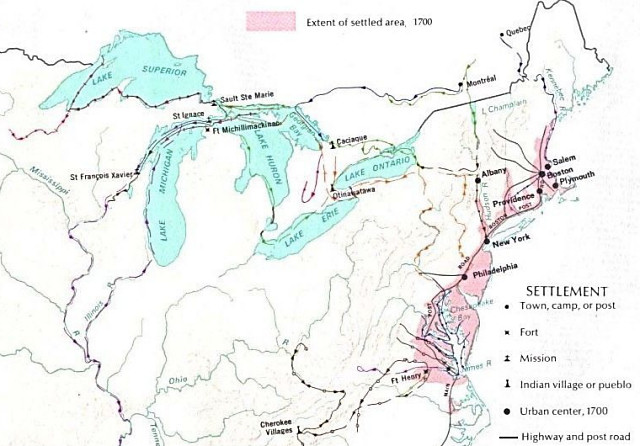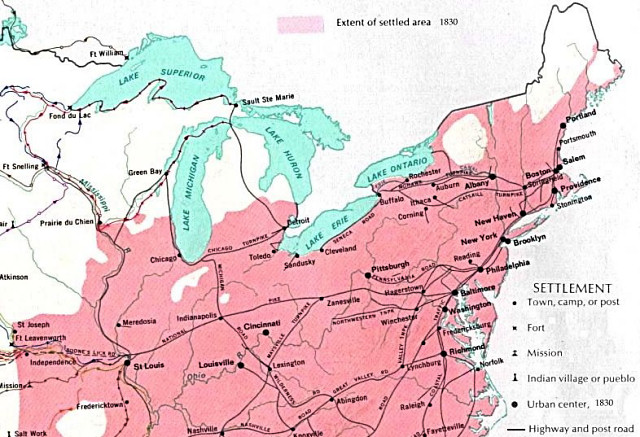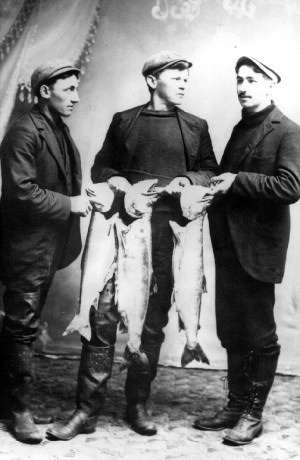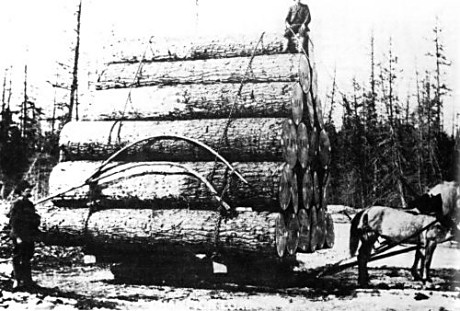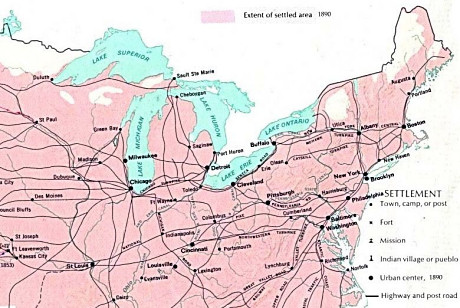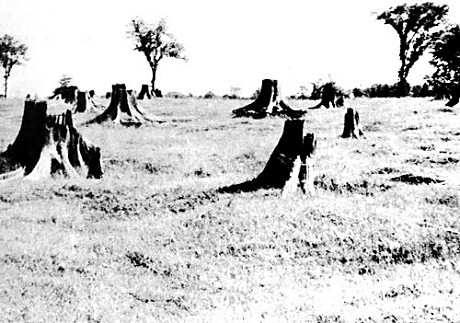Area History
Pre-1700
Prior to the arrival of European trappers and settlers, this area of Michigan was sparsely populated by Native Americans.
The Chippewa tribe had been living here since around 1525, but their main settlements were not in this area of the state.
The land was covered with rich pine and hardwood forests and populated with an abundance of wildlife.
The rivers and lakes were teeming with fish.
White fish, grayling, sturgeon, and herring were so plentiful that the local Native Americans easily maintained large stocks of dried fish for food and for use as trade goods.
Although some aspects of their life might have seemed rather idyllic, it must also be remembered that other tribes (notably the Iroquois) often made raids into this part of the Great Lakes and warred with the Chippewa and Huron tribes.
One of (if not the) first European explorers to come through this area was the French voyageur and explorer, Jean Nicolet in 1629. The famous French explorer LaSalle is also said to have visited this area in 1679. No known permanent settlements were established until much later though.
1819
Through the Treaty of Saginaw in 1819, all but 8,000 acres of Iosco county were purchased from the Saginaw Band of the Chippewa Indian Tribe.
The 8,000 acres (located near the mouth of the AuSable River) were kept by the tribe for hunting and fishing.
Later this area was also purchased for an annual stipend of $1,000.
The Indian settlement then moved north near the county line, where it still remains to this day.
1848
The first permanent European settlement in the county was established in 1848 at the mouth of the Au Sable river (todays Oscoda/AuSable area).
Primarily fishermen, they had come to harvest the immense fishery resources of the Lake Huron/Saginaw Bay waterways.
At the time, the only means of reaching this area was by ship.
No roads or railroads had stretched into this part of what was to become the state of Michigan.
Primarily shipping to Boston, New York and Chicago, they began harvesting what was then thought to be an "inexhaustible" supply of fresh water fish.
By 1864 Iosco county had 395 full time residents.
1850
In the 1850's and 60's fishing was "king", but another commercial venture was about to challenge for the crown.
The virgin White Pine forests had caught the eye of the lumbermen.
Huge stands of White Pine were scattered across the county.
Many of them within a few miles of the Au Sable river which provided an easy pathway for floating the logs down to the sawmills built on the shores of Lake Huron.
The cut lumber could then be easily transported by ship to Chicago.
1852
The first permanent structure in todays Tawas Bay area was begun in 1852 due to the "treacherous" shoals near the entrance to the bay.
This lighthouse was completed in 1853.
It was followed by the first European settlers in 1854.
The name of Ottawas Bay was shortened to Tawas Bay and the City of Tawas City was platted there in 1855.
1857
The State of Michigan established the County in 1857.
The original name was Kanotin county.
Kanotin means, "in path of the big wind", and was chosen following a devastating storm which caused Indians to avoid this area.
Henry Schoolcraft later renamed the county Iosco, which means "Water of Light".
1867
In 1867 lumbering became the second major industry in the area.
Up until this time the area remained almost unchanged from the virgin wilderness it had been.
Although settlements were springing up here and there, they were all along the lake shore and primarily dealt with the fishing industry.
However, the settlements springing up across the prairie states needed lumber.
With limited supplies of trees in the Dakotas, Nebraska, Kansas, etc. there was a huge need for lumber.
The forests of Michigan supplied this need.
1875
Due to the natural accretion of sand and sediment, Tawas Point had been extending itself out into what had once been open water at a rapid pace.
By 1870 the original lighthouse on the Point was of little realistic use for mariners.
In 1875 work was begun on a new lighthouse to replace it.
Placed on what was then the end of the Point, nearly 3/4's of a mile further southeast from the original lighthouse, this 68 foot tall structure was completed in 1876.
1887
A second, larger town was established just east of Tawas City along Tawas Bay in 1887 at a mill site.
Since the workers from Tawas City had referred to this site as "Going East", this became the present day city of East Tawas.
1890
By the 1890's the lumbering days were coming to an end.
Although short-lived, the logging era had a dramatic impact on this area.
Besides the colorful tales (it is believed by many that the Paul Bunyan tales originated in the Michigan lumber camps), a tremendous amount of damage had been done to the forests.
Huge tracts of land had been clear cut along the Au Sable river which stretches halfway across the state towards Lake Michigan.
These logging techniques had changed the forest into a wasteland, incapable of supporting much wildlife and causing severe erosion problems.
1895
The demise of the logging industry affected the permanent residents of the area pretty badly.
While fishing was still going strong (although starting to show some signs of depletion), other avenues were explored for producing income.
One such avenue lasted from the late 1800's until the 1920's.
Every winter, Tawas Bay was "harvested" for its ice.
It is easy for us to take refrigeration for granted but at that time the only way to "refrigerate" anything was with ice.
For three months of the year, huge amounts of ice were cut from the bay and shipped (mainly to Chicago and Detroit).
At peak production, Tawas Bay produced enough ice to fill and ship 100 railroad cars a day.
1900-1910
From 1900 to 1910 farming became one of the most important industries within the county.
Changes in technology would soon decimate this industry however.
With the coming of Henry Ford's automobile, a migration began from the farms to the auto factories downstate.
By 1916 this had resulted in literally hundreds of small family farms being left abandoned by their owners.
The factory pay of $5 a day was many times that which could be earned working on the farm.
That and a note printed in the local newspaper at the time may help to explain the phenomena:
"He told his son to milk the cows, feed the horses, slop the pigs, hunt the eggs, catch the colt and put him in the stable, split some kindling, get in the wood, stir the cream, put some fresh water in the creamery after supper and be sure to study his lesson before he went to bed; then the farmer went off to a meeting to discuss the question, 'How to keep the boys on the farm'."
1911
For the residents of Oscoda and AuSable, July 11,1911 brought the worst disaster in Iosco county history.
Five people lost their lives and 2,000 were left homeless when fire swept through and destroyed the two communities at the mouth of the AuSable river.
Many of the survivors of the fire received temporary aid and shelter from Tawas Bay residents immediately after the fire.
Soon however, they were back in Oscoda and AuSable rebuilding their homes and businesses.
1911-1924
From 1911 to 1924 the power of the Au Sable river was harnessed by the construction of six hydro-electric dams.
1920's
By the mid 1920's the fishing industry was beginning to slow down.
Depletion of the fishing stocks and pollution were beginning to take their toll.
Once the main industry for this area, commercial fishing continued to decline until it all but ended in the 1950's.
The 1920's also saw the beginning of a long term relationship between the people of Iosco county and the United States Army Air Corps (later to become the U.S. Air Force). What originally started as a summer training area for military flyers, was later to become Wurtsmith Air Force base, hosting a wing of Strategic Air Command B-52 bombers and KC-135 air refueling tankers.
1926-1950
From 1926 to the 1950's, a concerted effort was made to "undo" the damage done by the loggers of the late 1800's.
The land along the banks of the Au Sable river was planted with literally millions of trees.
The Civilian Conservation Corps enrollees planted 484,981,000 trees in the Huron-Manistee National Forests.
Additionally, Consumers Power Company (owners/operators of the Au Sable river hydro-electric dams) planted millions of pine trees along the banks of the Au Sable river to help stabilize the erosion problems.
1937
The year 1937 saw the completion of another long-time Tawas area landmark along the Tawas Bay shoreline.
The troopers assigned to the Tawas Post of the Michigan State Police have faithfully served all of the surrounding communities in this part of the state since then.
1942-1943
During the war years of 1942 and 1943, the women of the Tawases did their part for the war effort.
At that time memories of the horrors experienced in the trenches of World War I were still very strong.
Fears of similar poison gas attacks on the United States (primarily to the West Coast) led to the creation of a short-lived (thankfully) local industry.
At peak production, the Tawas City plant produced up to 42,000 gas masks a day for the civilian population of the country.
The plant which produced these masks was almost wholly "manned" by local women from the surrounding communities.
1965
Tawas Point State Park was acquired and developed in 1965.
This 175 acre (depending on water level) site has camping facilities, picnic areas, the Tawas Point lighthouse and beaches on both the Lake Huron and Tawas Bay sides.
It attracts over 250,000 visitors annually.
1993
With the drawdown in military bases in the 1990's, Wurtsmith Air Force base was scheduled for closure.
The final closure ceremonies in 1993 marked the end of a long friendship between the people of Iosco county and the many military personnel stationed at the base.
While the closure affected the local economy to some extent, it was offset by the dedicated efforts of a multitude of people at the local, state and federal levels.
Hailed as an example of "how to", the re-use efforts here have become a model for many other small communities facing similar situations.
The former Wurtsmith Air Force base now hosts several commercial ventures which have created a number of local civilian jobs.
Today Iosco county has recovered much of it's past beauty. Most of the county is covered by mature forest once again. The autumn colors are spectacular and the habitat for wildlife has improved to the point where certain species are seen by some as a bit of a nuisance (it seems that some white tailed deer have taken a real liking to the shrubbery some residents have planted around their homes. Bald eagles and trumpeter swans are once again regular residents along the Au Sable river where nesting pairs are successfully rearing their young. While it is doubtful that the fisheries will ever reach the levels they once enjoyed, local waters today provide an abundance of brown trout, lake trout, steelhead, salmon, perch, and walleye for the sport fisherman.
NOTE: Several of the above pictures are provided courtesy of Neil Thornton.
Copyright 1996-2017 - All rights reserved
These pages provided courtesy of Rick Simon - All inaccuracies, errors, and/or inanities are his responsibility.
These pages provided courtesy of Rick Simon - All inaccuracies, errors, and/or inanities are his responsibility.





